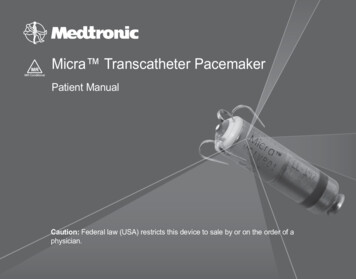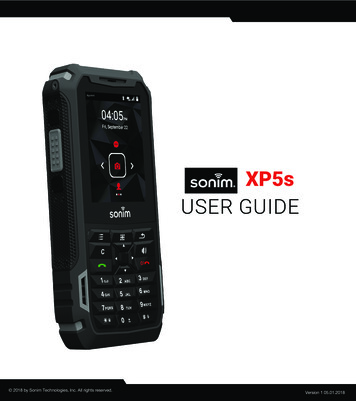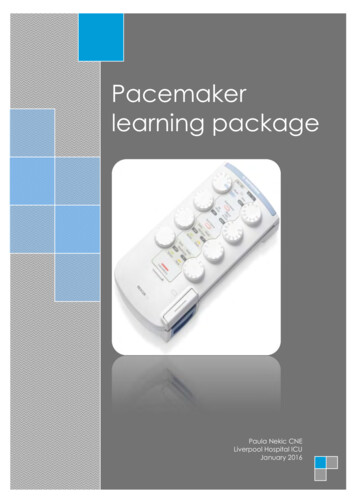
Transcription
Micra Transcatheter PacemakerPatient ManualCaution: Federal law (USA) restricts this device to sale by or on the order of aphysician.
We are there when you need us.The following list includes trademarks or registered trademarks of Medtronic inthe United States and possibly in other countries. All other trademarks are theproperty of their respective owners.Medtronic, Micra, SureScan
ContentsInformation about you and your pacemaker 9Chapter 1 Why read this manual? 13Frequently asked questions 13Chapter 2 About your pacemaker 23What is a pacemaker? 24What is a transcatheter pacemaker, and how is it differentfrom other pacemakers? 25What are the components of my pacemaker? 26How does a pacemaker work? 28What is a pacing therapy, and what does it feel like? 28What types of therapy can my pacemaker provide? 29Fixed rate therapy 29Rate-responsive therapy 29Chapter 3 Your implant procedure and recovery333
The implant procedure 34How the procedure is done 34Potential risks after the implant procedure 35Recovering after your implant procedure 36When to call your doctor or nurse 37Follow-up appointments 38Chapter 4 Living life with your pacemaker 39Food and medications 40Recommendations about your physical activity 40Recreation and activities 41Driving a car 41What you need to know about electromagneticcompatibility (EMC) 42General guidelines for avoiding interference fromelectrical items or magnets 44Household and hobby items with motors and other itemsthat cause electromagnetic interference (EMI) 46Home power tools 484
Industrial equipment 49Radio transmitters 50Security systems 51Examples of items that have low or no risk of interferingwith your pacemaker 53Precautions about medical procedures 55Medical procedures that are not recommended 55Medical procedures that require some precautions 56Acceptable medical procedures 60Chapter 5 Registering your pacemaker 61Pacemaker registration form 62Your pacemaker ID card 62Carry your pacemaker ID card with you at all timesTo request a new ID card or update your personalinformation 63If you change your doctor 63Medtronic pacemaker travel card 64Chapter 6 Caring for yourself63655
Shaping a positive attitude about life with your heartdevice 66Dealing with anxiety and getting the support you needMedical care 68Planning for an emergency 69What your family and friends should know 70Chapter 7 Follow-up care 71Follow-up appointments 71Medtronic programmer 73Reviewing information saved by your pacemakerPacemaker replacement 74Chapter 8 Your heart has a natural rhythm 77The anatomy of the heart 77Electrical conduction in the heart 81How abnormal heart rhythms affect the heartBradycardia 85Glossary689847367
Index957
8
Information about you and your pacemakerYour personal informationYour nameYour doctor’s nameSpecialtyYour doctor’s nameSpecialtyYour medicationsPhonePhone9
Emergency contact r pacemaker informationType of pacemakerSerial #Date of implantHospital where implanted10
How to contact MedtronicContact us by phoneOur experienced Patient Services group is available to answer anyquestions or concerns you may have about your heart device. To speakdirectly with a Patient Services Specialist, call 1-800-551-5544. Our staffis available Monday through Friday from 8:00 AM to 5:00 PM (CentralTime).Contact us onlineMedtronic is dedicated to providing you with the most up-to-dateinformation available about your Medtronic heart device. Websiteinformation is available 24 hours a day. Medtronic website: www.medtronic.comPatient Services website: www.medtronic.com/rhythmsIf you would like to submit questions, suggestions, or requests to usonline, you can use the online form provided atwww.medtronic.com/corporate/contact.jsp.11
Contact us by mail or faxMedtronic Inc.Patient Services DepartmentMail Stop MVS 148200 Coral Sea Street NEMounds View, MN 55112Fax: (763) 367-5809Contacting Medtronic about your ID CardTo update information on your ID card or if you have questions aboutyour ID card, see “Your pacemaker ID card” on page 62.Medtronic WarrantyFor complete warranty information, call Medtronic Patient Services at 1800-551-5544. Our staff is available Monday through Friday from 8:00AM to 5:00 PM (Central Time)12
1Why read this manual?Your doctors should be your first source of information about your heartcondition and your general health.This manual is for people who are about to have or already have aMedtronic Micra transcatheter pacemaker. This manual explains whatthe pacemaker is, what pacing therapies it provides, how it is implanted,and what you can expect after you have your pacemaker. It is a goodidea to encourage your family and caregivers to read this manual.Words that appear in bold are defined in the glossary starting onpage 89.Frequently asked questionsNew patients often have the same initial concerns about theirpacemakers. Here are some of the questions that new patients frequentlyask.13
Why do I need this pacemaker?Based on your individual health condition, your doctor has determinedthat the treatment provided by this pacemaker may help to improveyour symptoms. Although this pacemaker does not prevent or cure yourunderlying heart rhythm condition, it does help to protect you fromheart rhythms that can weaken or even endanger your health. Having apacemaker should also improve your quality of life. Many patients saythat a pacemaker gives them and their families a sense of security.The most common medical condition that needs a pacemaker isbradycardia. Bradycardia is an abnormally low heart rate that is lessthan 60 beats per minute during normal activities of daily living. Apacemaker stimulates or increases the heart rate to a level that meets thedemands of everyday living.Who should not receive this pacemaker (contraindications)?Patients with previously implanted medical devices or certain healthconditions may not be eligible to receive this pacemaker. Consult yourdoctor to determine whether or not this pacemaker is right for you.14Why read this manual?
Is it safe for me to have an MRI scan?A magnetic resonance imaging (MRI) scan is a type of medical imagingthat uses magnetic fields to create an internal view of the body, whichdoctors use for diagnostic purposes. You can undergo an MRI scan aslong as you meet the patient eligibility requirements that Medtronicprovides to your heart doctor. Your pacemaker ID card specifies yourimplanted device model.Unlike earlier generations of pacemakers, your Micra pacemaker wasdesigned, tested and approved to be used safely with MRI scanners. Theelectromagnetic fields present during MRI scans have the potential tocause hazardous effects on pacemakers, which can result in cardiactissue heating, inappropriate pacing, and dangerous arrhythmias. Dueto the unique design of this pacemaker, these risks are reduced to a verylow level so that under specified conditions, patients may safelyundergo MRI scans.Prior to receiving an MRI scan, your doctor will verify that you meet thepatient eligibility requirements, verify that your pacemaker isChapter 115
functioning properly, and ensure that the SureScan feature isprogrammed to “On”.During the MRI procedure, you are monitored continuously to ensureyour safety.If you have questions about your eligibility to receive an MRI scan,contact your doctor or nurse. If any of your doctors have questions, theyshould contact a Medtronic representative or Medtronic TechnicalServices.Will I be able to drive?Whether you will be able to drive depends on your individual heartcondition. Many people with pacemakers are able to resume driving iftheir doctors approve and if allowed by the laws and insuranceregulations in their states. For more information, see “Driving a car” onpage 41. If you have concerns, talk with your doctor.16Why read this manual?
Will I be able to travel?Most people who have pacemakers can travel without taking specialprecautions if they follow their doctor’s instructions. Wherever youtravel, your pacemaker continues to monitor your heart and providetherapy when it is needed.It is unlikely that your pacemaker will trigger the security gates atairports or other secure buildings. If it does, present your pacemaker IDcard. If a handheld screening wand is used, ask the security operator notto hold it over your pacemaker and not to wave the wand back and forthover your pacemaker. See “Security systems” on page 51 for moreinformation.A multilanguage pacemaker travel card is available that givesinstructions in several languages for safe security scanning; the card isespecially useful for international travel. See page 64 for moreinformation about the multilanguage pacemaker travel card.If you have any other travel-related questions, consult the Medtronictravel website at www.medtronic.com/traveling.Chapter 117
Can I walk through antitheft systems found in public places?Yes, simply walk through the antitheft system at a normal pace. Undersome circumstances, the systems located in stores, libraries, and otherplaces may temporarily interfere with your pacemaker if you stop orlinger near this equipment. The interference stops when you move awayfrom the equipment.Can I use a mobile phone?Yes, you can use mobile phones, including cellular phones and otherwireless phones. For more information about using mobile phones andother wireless communication devices, see “General guidelines foravoiding interference from electrical items or magnets” on page 44.Can I use a microwave oven and other electrical items?Yes, you can use a microwave oven as well as major appliances, electricblankets, and heating pads. See “Living life with your pacemaker” on18Why read this manual?
page 39 for information about electrical items and any restrictions orcautions you should know about.Will my pacemaker need to be replaced?Yes. Because your pacemaker operates using a battery sealed inside thepacemaker, you will need to get a new pacemaker when battery powerfalls to a low level. Battery power is affected by many factors, includingthe nature of your heart condition. Although battery life may vary, theestimated average longevity for this pacemaker is 12 years after it isimplanted, based on device settings observed in the Micra clinical trial1.The battery power is checked at each pacemaker follow-upappointment. Your doctor or nurse will let you know when you need anew pacemaker.1Reynolds D, Duray GZ, Omar R, et al. A leadless intracardiac transcatheter pacing system.N Engl J Med. DOI: 10.1056/NEJMoa1511643Chapter 119
How often will my doctor need to check my pacemaker?The first follow-up appointment is typically scheduled about 1 monthafter your implant procedure. Additional follow-up appointments arescheduled every 3-6 months, depending on your doctor’s normalpractice and your medical condition. These follow-up appointments canbe performed at your clinic. For more information about follow-upservices, see “Follow-up care” on page 71.How do I know if my pacemaker battery is still working?The strength of your pacemaker battery is checked during yourfollow-up appointments. Because the battery is sealed inside yourpacemaker and cannot be recharged, you will need a new pacemakerwhen the battery power is low. For more information about pacemakerreplacement, see “Pacemaker replacement” on page 74.Can I have sexual relations?20Why read this manual?
People often have questions about resuming sexual relations afterreceiving a pacemaker. Most people resume sexual activity, based ontheir doctor’s guidance. You and your partner should be able to enjoy allthe benefits of intimacy.Chapter 121
22Why read this manual?
2About your pacemakerYour doctor has prescribed a Medtronic Micra transcatheter pacemakerto relieve your symptoms of heart rhythm disturbances. Although thispacemaker does not prevent or cure your underlying heart rhythmcondition, it may improve the quality of your life.This chapter should answer many of your questions about yourpacemaker, including the following questions: What is a pacemaker? What is a transcatheter pacemaker, and how is it different from otherpacemakers? What are the components of my pacemaker? How does a pacemaker work? What is a pacing therapy, and what does it feel like? What types of therapy can my pacemaker provide?23
If you have questions that are not answered in this manual, ask yourdoctor or nurse.What is a pacemaker?A pacemaker is an implanted medical device that stimulates the heartmuscle with timed pulses of electricity (called pacing therapy or simplytherapy). These small amounts of electricity cause the heart to contract,mimicking a naturally occurring heart rhythm.A pacemaker relieves symptoms of heart rhythm disturbances byrestoring normal heart rates. If the heart is beating too slowly (calledbradycardia), a pacemaker responds with therapy to restore a normalheart rate.A normal heart rate provides your body with the proper amount ofblood circulation. This stops the fatigue, dizziness, and shortness ofbreath caused by your heart beating too slowly. It also improves yourbreathing comfort during normal activities.Although a pacemaker relieves symptoms for most patients, it does notprevent or cure heart disease or prevent heart attacks.24About your pacemaker
What is a transcatheter pacemaker, and how is itdifferent from other pacemakers?A traditional pacemaker is implanted in the chest and connected to leadsthat are inserted into the heart. Unlike a traditional pacemaker, atranscatheter pacemaker has no leads and is implanted directly into theright ventricle of the heart (see Figure 1). The Micra pacemaker is aboutone inch long and about one quarter of an inch wide. It is called atranscatheter pacemaker because it is attached to a catheter deliverysystem. This system is used to carry and position the pacemaker in thecorrect location in the heart. The pacemaker is implanted through anincision, generally in the groin area of the leg. After the pacemaker isimplanted, the catheter delivery system is removed.Chapter 225
Figure 1. Transcatheter pacemaker in the right ventricle of the heartWhat are the components of my pacemaker?Your pacemaker contains a very small computer that is powered by atiny lithium battery. All electronic components are sealed inside a26About your pacemaker
titanium metal case. Tines attached to the outer case help position andhold the pacemaker in place. See Figure 2.Figure 2. Pacemaker components31421. Tines2. Computer3. Battery (in titanium case)4. Titanium case Tines. The flexible tines hold or fix the pacemaker to the heart. Computer. The computer controls the timing and intensity of theelectrical impulses delivered to the heart that stimulate the heart tobeat.Chapter 227
Battery. The pacemaker is powered by a small, sealed lithium battery. Titanium case. The battery and computer are sealed inside a metalcase that is sometimes called a “can”.How does a pacemaker work?When the heart’s own rhythm is interrupted, irregular, or too slow, thepacemaker sends an electrical impulse to the heart. This pacing pulsestarts a heartbeat. The pacemaker also monitors (or senses) the heart’snatural electrical activity. This is called sensing. The pacemaker does notdeliver a pacing pulse when it senses a natural heartbeat.What is a pacing therapy, and what does it feel like?If your heart’s rhythm becomes too slow, your pacemaker delivers asteady pattern of small electrical pulses to your heart to encourage aregular heartbeat. This is called pacing your heart. The pacing therapyprovided by your pacemaker makes sure that your heart maintains aheart rhythm that supports your body’s needs.Most people do not feel pacing therapies when they are delivered. Thefew that report feeling this type of therapy describe it as painless.28About your pacemaker
What types of therapy can my pacemaker provide?Your doctor has set up your pacemaker to deliver the most effectivetypes of therapy for your specific heart rhythm condition. Yourpacemaker provides fixed rate therapy and rate-responsive therapy.Fixed rate therapyFixed rate therapy paces the heart at a steady rate that does not increaseduring activities, such as exercise, or decrease when you are resting.Rate-responsive therapyA normal heart rhythm slows down or speeds up many times during theday. Your heart beats slower while you are resting or sleeping. It beatsfaster in response to exercise or excitement. Your heart rate changes tosupply the blood your body needs during your changing levels ofactivity.When your heart cannot adjust its rate to meet the needs of your body,rate-responsive therapy or pacing is needed. This type of pacing variesits rate depending on your level of activity. A rate-responsivepacemaker uses one or more special sensors to monitor changes in yourChapter 229
body. The pacemaker uses this information to increase or decrease yourheart rate.Patients who have rate-responsive pacing report feelings of well-beingand the ability to resume active and satisfying lifestyles. Variations inpacing rate allow you to perform your everyday activities with ease. Ifyou are walking, exercising, or gardening, the pacemaker automaticallyadjusts your heart rate to match your level of activity. When you slowdown, rest, or sleep, the rate decreases.You do not need to engage in strenuous activity to benefit from arate-responsive pacemaker. The simple act of walking may require a rateof more than 100 beats per minute, as shown in Figure 3.30About your pacemaker
Figure 3. Rate-responsive pacing adjusts the pacing rate according tothe needs of your body.Rate responsive pacingNormal heart rate543162Daily activities1. Sleeping2. Wake-upChapter 23. Sitting4. Walking5. Running6. Resting31
32About your pacemaker
3Your implant procedure andrecoveryBeing told you need a pacemaker can be upsetting, but knowing what toexpect about your implant procedure can help reduce your concern. Theimplant procedure does not require open heart surgery. You will begiven medication to make you sleepy and comfortable. Typically youwill also be given local anesthesia at the access site.Usually you will stay in the hospital overnight and go home the nextday. Your doctor will give you instructions on caring for your incision aswell as any limitations you may have.This chapter covers information about the following topics: The implant procedurePotential risks after the implant procedureRecovering after your implant procedureWhen to call your doctorFollow-up appointments33
The implant procedureThe procedure for implanting the pacemaker uses a catheter with anavigation handle called a delivery system. The delivery system holdsthe pacemaker and allows the doctor to move the pacemaker into thecorrect position and place it in the right ventricle of the heart. Theimplant procedure generally takes 1 hour or less.How the procedure is done1. Your doctor inserts the catheter delivery system into your veinthrough a small incision at the access site, typically in the groin areaof your leg.2. The doctor uses the delivery system to move the pacemaker into theright ventricle of your heart.3. Once the delivery system is in the correct position, the doctor fixesthe pacemaker into the muscle of your heart using the tines on thepacemaker.4. The doctor uses a small external programmer to test and programyour pacemaker.5. The doctor then removes the delivery system through the access site.34Your implant procedure and recovery
6. The doctor or other medical professional closes the incision at theaccess site, completing the procedure.Potential risks after the implant procedureYour doctor and Medtronic have attempted to minimize the risksassociated with implanting this pacemaker. However, as with anysurgery, there are potential risks.The following potential risks are associated with implanting yourpacemaker: tearing of the blood vessel where the catheter was insertedbleeding from the site where the catheter was insertedpain, swelling, or bruising at the site where the catheter was insertedinfectionperforation of the heart chamberblood clotsheart attackstrokeChapter 335
Recovering after your implant procedureAfter your pacemaker is implanted, your doctor may order tests such asan electrocardiogram (ECG), blood tests, or x-rays to confirm thelocation of your pacemaker. The operating settings of your pacemakermay also be checked again to make sure that your pacemaker isproviding the best treatment for your heart condition.As you recover, follow your doctor’s suggestions about resumingnormal activities. Here are general recommendations for the first fewweeks after your implant procedure: Call your doctor immediately if any swelling, warmth, or drainageappears around the incision or if you develop a fever. Use care when exercising and bathing, according to your doctor’sdirections. Avoid tight clothing that may irritate your incision. Avoid lifting more than 10 to 15 pounds (5 to 7 kilograms). Avoid pushing or pulling heavy objects.36Your implant procedure and recovery
Tell your doctors and your dentist that you have a pacemaker. Theymay choose to prescribe antibiotics for you to take before and aftersurgery or dental work to prevent infection.When to call your doctor or nurseContact your doctor or nurse if you experience any of the followingsituations: You notice swelling, warmth, or drainage around your incision, or ifyou develop a fever while your incision is healing. You notice new, unexplained heart symptoms, or you areexperiencing the same symptoms you experienced before receivingyour pacemaker. You have heart rhythm symptoms that last longer than 3 minutes (orany length of time specified by your doctor). These symptoms caninclude extreme fatigue, racing heart, pounding heart, and feelingfaint or dizzy.Chapter 337
Follow-up appointmentsYour doctor or nurse will work with you to schedule follow-up careappointments. For more information about these appointments, readChapter 7, “Follow-up care” on page 7138Your implant procedure and recovery
4Living life with your pacemakerMany people resume their normal daily activities after full recoveryfrom their implant procedure. However, there may be certain situationsthat your doctor will ask you to avoid. Your doctor will provide the mostimportant guidance for your particular condition.This chapter has important information about the following topics: Food and medications (see page 40) Recommendations about your physical activity (see page 40) What you need to know about electromagnetic compatibility (EMC)(see page 42) Precautions about medical procedures (see page 55)39
Food and medicationsYour doctor may instruct you to eat or avoid eating certain foods. Yourdoctor may also prescribe medications that will treat your heartcondition. Talk with your doctor to get specific information about foodand medications.Recommendations about your physical activityUpon the advice of your doctor, you can gradually return to yournormal lifestyle and to activities such as these: pursuing hobbies or recreational activitiesreturning to your jobresuming strenuous activityresuming sexual activitytravelingYour doctor might ask you to avoid situations where a few seconds ofunconsciousness could be dangerous to you or others. These situationsmay include driving, swimming or boating alone, or climbing a ladder.40Living life with your pacemaker
Recreation and activitiesAsk your doctor if there are any activities that you should avoid afteryour implant procedure. Your doctor may suggest that you limit yourphysical activity, which could include the following restrictions: no heavy lifting limited walking no climbing stairs or laddersIf you have additional questions about any recreational activities younormally pursue, contact your doctor or nurse.Driving a carDiscuss with your doctor whether you can safely drive a car or othervehicle. You may be able to resume driving, depending on local lawsand insurance regulations and on your medical condition. Your doctorwill decide what is best for your safety and the safety of others.There are no special restrictions for hybrid cars. You can drive and ridein hybrid cars just as you would in non-hybrid cars.Chapter 441
What you need to know about electromagneticcompatibility (EMC)Everything that uses electricity produces an electromagnetic energyfield. This energy field surrounds the electrical item while it isconnected to a source of electricity (even a battery source). The energyfield is strongest near the item and weakens with distance from the item.The relationship between these energy fields and your pacemaker iscalled electromagnetic compatibility (EMC). Most electromagneticenergy fields are small and weak and do not affect your pacemaker.Electrical items that generate strong electromagnetic energy fields maynot be compatible with your pacemaker.Safeguards are built into your pacemaker to shield it from strongelectromagnetic energy fields. For example: The metal case of your pacemaker acts as a shield againstelectromagnetic energy fields. Electronic filters are built into your pacemaker that help yourpacemaker distinguish between external electromagnetic energyfields and the internal electrical pulses of your natural heartbeat.42Living life with your pacemaker
You can avoid potential electromagnetic interference by keeping yourpacemaker a minimum distance away from the electrical item. See thefollowing pages for more information, including the recommended safedistances for certain types of electrical items.How could electromagnetic energy fields affect my pacemaker?High electromagnetic energy fields could affect how your pacemakersenses your heart rhythm. Because your pacemaker is designed to sensethe electrical activity of your heart, it may also sense a strongelectromagnetic energy field outside your body.If your pacemaker is exposed to a strong electromagnetic energy field, itmay not detect an abnormal heart rhythm or it may deliver a pacingtherapy when your heart does not need it. Any effects of electromagneticenergy fields on your pacemaker are temporary and will stop when youmove away from the source of the electromagnetic energy field.Chapter 443
What about static electricity or shocks from household outlets?Static electricity shocks will not damage your pacemaker. A momentaryshock from a household electrical outlet (110/220 volts) is unlikely todamage your pacemaker, depending on how long you stay in contactwith the outlet.What items are safe, and what kind of precautions do I need to take?Most electrical items are safe for you to use. However, you should keepsome items that produce a stronger electrical field a minimum distanceaway from your pacemaker. This minimum distance can range from 6 to12 inches (15 to 30 centimeters) or more, depending on the type of item.Refer to the information beginning on page 46 for recommended safedistances.General guidelines for avoiding interference from electricalitems or magnetsThe following pages provide tips on how to avoid any possibletemporary effects of electromagnetic energy fields on your pacemaker. If44Living life with your pacemaker
you have questions about electromagnetic energy fields or the safe useof a specific item that is not listed in this chapter, consult with yourdoctor or nurse.Area restrictionsBefore entering an area where signs are posted prohibiting persons withan implanted cardiac device, such as a pacemaker or implantablecardioverter defibrillator (ICD), consult with your doctor.Symptoms of electromagnetic interference (EMI)If you become dizzy or feel rapid or irregular heartbeats while using anelectrical item, release whatever you are touching or move away fromthe item. The pacemaker should immediately return to normaloperation. If symptoms do not improve when you move away from theitem, consult with your doctor.Proper grounding of electrical itemsTo avoid interference from electrical current that may leak fromimproperly grounded electrical items and pass through the body,observe the following precautions:Chapter 445
Make sure that all electrical items are properly wired and grounded. Make sure that electrical supply lines for swimming pools and hottubs are properly installed and grounded according to local andnational electrical code requirements.Household and hobby items with motors and other items thatcause electromagnetic interference (EMI)Household and hobby items that have motors or magnets or thatgenerate electromagnetic energy fields could interfere with yourpacemaker. Keep your pacemaker at least 6 inches (15 centimeters) awayfrom the following items: Handheld kitchen appliances, such as electric mixers Sewing machines and sergers Personal care items, such as corded handheld hair dryers, cordedelectric shavers, electric or ultrasonic toothbrushes (base charger), orelectric massagers46Living life with your pacemaker
The following household and hobby items require special precautions: Boat motors – Keep your pacemaker at least 12 inches(30 centimeters) away from electric trolling motors or gasolinepowered boat motors. Electronic body fat scale – Using this type of scale is notrecommended for pacemaker patients because it passes electricitythrough the body and can interfere with the pacemaker. Electronic pet fences or invisible fences – Keep your pacemaker atleast 12 inches (30 centimeters) away from the buried wire and theindoor antenna of electronic pet fences or invisible fences. Home-use electric kilns – Keep your pacemaker at least 24 inches(60 centimeters) away from home-use electric kilns. Induction cook tops – An induction cook top uses an alternatingmagnetic field to generate heat. Keep your pacemaker at least24 inches (60 centimeters) away from the heating zone when the
Bradycardia is an abnormally low heart rate that is less than 60 beats per minute during normal activities of daily living. A pacemaker stimulates or increases the heart rate to a level that meets the demands of everyday living. Patients with previously implanted medical devices or certain health










